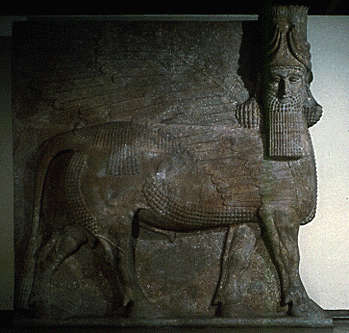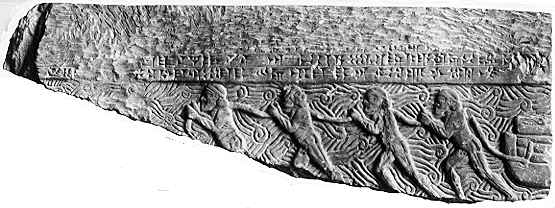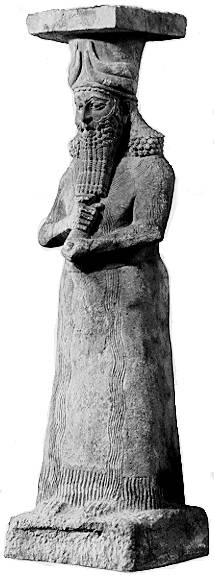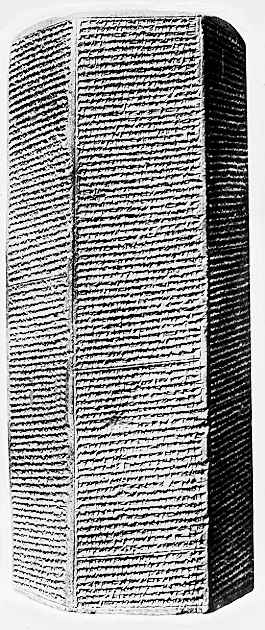Many of these images came from the Oriental Institute at the University of Chicago.
Due to the number of images on this page, it takes
a while to load.
Why not take a break and grab a cup of coffee and
a fresh danish. You might be here for a few.
Assyria
![]()
 |
Iraq: Khorsabad, Palace, Court VIII
Neo-Assyrian Period Reign of Sargon II, 721-705 B.C. Gypsum (?) 495.3 cm H, 491.4 cm W This colossal sculpture was one of a pair that guarded
the entrance to the throne room of King Sargon II. A protective spirit
known as a "lamassu", it is shown as a composite being with the head of
a human, the body and ears of a bull, and the wings of a bird. When viewed
from the side, the creature appears to be walking; when viewed from the
front, to be standing still. Thus it is actually represented with five,
rather than four, legs.
|
 |
Iraq: Khorsabad, Palace, Throneroom Debris
Neo-Assyrian Period Reign of Sargon II, 721-705 B.C. Gypsum 43.0 cm H, 119.5 cm W This fragment shows naked Assyrian soldiers towing a boat through a shallow river, perhaps during one of Sargon's campaigns against Marduk-apla-iddina II, king of Babylon, whose name is inscribed in the text above the scene. |
 |
Iraq: Khorsabad, Palace, Court VIII Neo-Assyrian
Period
Reign of Sargon II, 721-705 B.C. Gypsum 308.0 cm H, 249.7 cm W This relief comes from a wall just outside the throne
room of Sargon II's palace. Two court officials - who are beardless and,
therefore, possibly identifiable as eunuchs - are shown marching toward
the king. The second figure motions to the line of men that stood behind
him to come forward toward the king. He stands with his back toward the
viewer, as can be seen by the position of his hands and garment, which
covers his left shoulder. Traces of the paint originally used for coloring
the sculpture still remain on portions of the relief.
|
 |
Iraq: Khorsabad, Nabu Temple
Neo-Assyrian Period Reign of Sargon II, 721-705 B.C. Gypsum (?) 151.2 cm H, 45.3 cm W These two statues once flanked a doorway leading into
the temple of Nabu, the god of writing and of knowledge. Nearly identical
sculptures were found at the entrances to other temples at Dur-Sharrukin.
As well as representing minor deities, the figure also may have served
as supports for as-yet-unidentified objects, as there are saucer-like hollows
cut into the square blocks resting on their crowns.
|
 |
Iraq: Khorsabad, Shamash Temple
Neo-Assyrian Period Reign of Sargon II, 721-705 B.C. Bronze 61.0 cm H The fortress of Sargon II at Khorsabad included a complex of temples, one of which was devoted to the sun god Shamash. This bronze band encircled one of a pair of cedar poles-possibly supports for divine emblems-that once flanked the doorway to this temple. The band was affixed to the pole by nails driven through the centers of the rosettes that decorate the three narrow bands framing the two main registers. In the upper register, Sargon is shown grasping two massive bulls by the horns. This ancient motif, known as "the master of animals," was well established in Mesopotamian royal iconography and perhaps symbolized the dominance, vitality, and potency of the reigning monarch. To the left of the king and bulls is a large bird depicted in flight, to the right, facing the king and bulls, is an attendant wearing a kilt. In the lower register, only a fig tree and the tip of a plough are preserved.
|
 |
Iraq: Nimrud, N.W. Palace, Room G
Neo-Assyrian Period Reign of Ashurnasirpal II, ca. 883-859 B.C. Gypsum (?) 61.2 cm H, 58.0 cm W Room G in Ashurnasirpal II's palace may have served
as the setting for a ritual by which weapons were purified. The walls of
this chamber were adorned with exceptionally well-carved and minutely detailed
reliefs showing the king standing between, alternately, two courtiers and
two winged genies. This fragment shows the king himself, identifiable by
his fez-shaped cap surmounted by a conical spike. Originally, this piece
formed part of a scene. The king, grasping a bow, stood ready to pour a
libation from a cup poised delicately on the tips of his fingers. Facing
him was an attendant who carried a fly-whisk with which to banish insects
from the royal presence.
|
 |
Iraq: Nineveh (?)
Neo-Assyrian Period Reign of Sennacherib, ca. 689 B.C. Baked clay, inscribed 38.0 cm H, 14.0 cm W On the six inscribed sides of this clay prism, King
Sennacherib recorded eight military campaigns undertaken against various
peoples who refused to submit to Assyrian domination. In all instances,
he claims to have been victorious. As part of the third campaign, he beseiged
Jerusalem and imposed heavy tribute on Hezekiah, King of Judah-a story
also related in the Bible, where Sennacherib is said to have been defeated
by "the angel of the Lord," who slew 185,000 Assyrian soldiers (II Kings
18-19).
|
![]()
|
|